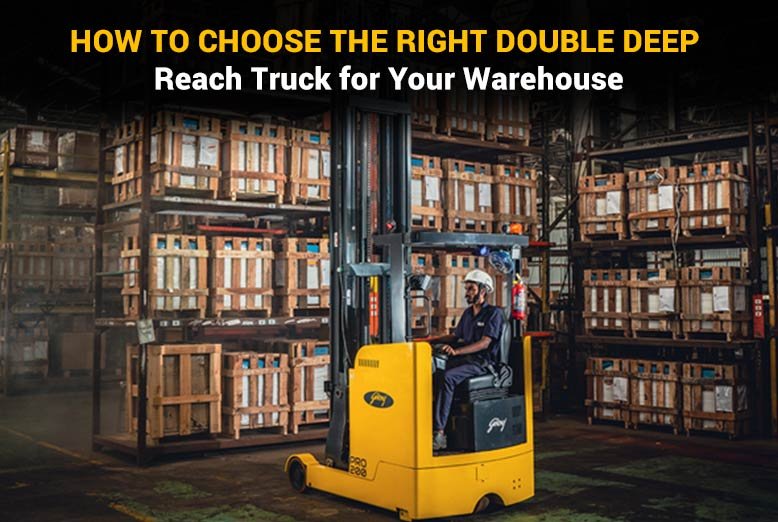Warehouse managers don’t always have the luxury of space. As racking systems become taller and aisle widths narrow, lifting equipment must do more with less. That’s exactly where a double deep reach truck proves its worth. Designed to extend beyond the capabilities of standard reach trucks, these machines help store pallets two rows deep by maximising vertical and horizontal space without major layout changes.
But choosing the right one isn’t as simple as picking a machine off a rental list. You need to consider factors such as lifting capacity, aisle width, operator skill, power source, and ongoing material handling maintenance. If you’re looking to streamline warehouse operations without breaking structure or budget, this post offers a practical breakdown to make that decision easier.
Understand Your Storage Requirements Before Choosing a Truck
Every warehouse has its own rhythm. In some places, the pressure is on height. In others, the space between aisles is the bigger problem. Before selecting a model, it’s essential to understand your load characteristics and racking setup. Are your pallets mostly uniform or mixed sizes? Do you need access to all loads at all times, or can you afford double-depth storage where the rear pallet is accessed less frequently?
A double deep reach truck enables you to store two pallets in a single bay, thereby immediately increasing storage density. But it also reduces selectivity. Therefore, it works well for slow-moving SKUs or large-volume items that are stored in pairs. This choice becomes especially effective in high-density operations, such as 3PL warehouses, e-commerce hubs, and pharmaceutical cold storage facilities, where airspace is valuable and layout flexibility is limited.
Review Technical Specs: Don’t Settle for Just Lifting Capacity
While capacity, typically ranging from 1.4 to 2 tonnes, is important, it’s just one piece of the puzzle. You need to think about lift height too. Many warehouses today operate with racking systems that extend well above 10 metres, and some double-deep reach truck models offer a maximum fork height (MFH) of 11 metres as standard.
Account for Aisle Width and Manoeuvrability in Layout Design
One of the biggest mistakes people make while bringing in reach trucks is underestimating turning radii and clearance paths. The deeper the truck reaches, the more carefully you need to plan the aisle.
Before leasing or buying, map out the working aisle width based on your current racking and floor markings. It helps to test the machine, or at least simulate its range, before locking it in. Reach trucks are designed for tight spaces, but even the best-designed models can become inefficient if aisle widths are too narrow.
If you’re renting, most premium providers, such as Godrej RenTRUST, will help you assess compatibility before dispatch. But it’s worth double-checking with your facility team as well. Even small errors, such as an awkward slope near the bay, can cause delays or prompt operators to avoid a particular aisle altogether.
Don’t Overlook Material Handling Maintenance Support
No matter how advanced your reach truck is, its performance will dip without proper maintenance and upkeep. Daily wear and tear on tyres, hydraulics, and lifting components is unavoidable. What matters is how quickly issues are caught and fixed. That’s why material handling maintenance must factor into your decision-making process.
Some rental partners include routine checks as part of the agreement. Others expect your team to manage that in-house. Either way, having a documented service schedule with visual checks and trigger points (for battery levels, forks, mast, reverse alarms, etc.) keeps operations from stalling mid-shift.
Evaluate Rental Terms and Flexibility Upfront
Whether you’re testing equipment before a full upgrade or managing a seasonal surge, rentals provide you with the breathing room you need. But flexibility isn’t just about start and end dates. It’s also about what’s included in your rental. Does the contract offer operator support? How quickly is a replacement dispatched in the event of a breakdown? Are forks, guards, and other accessories billed separately?
Some providers offer bundled options that include full maintenance, spare batteries, and even breakdown replacement. This is especially useful when you’re running high-volume operations where a spare machine is not always on standby.
If you’re looking for scalable rental plans, look out for providers with pan-India support. For example, premium rental brands like Godrej RenTRUST are known for their full-suite warehouse solutions, from equipment to manpower and technical service, available across multiple cities.
Use Cases: Where Double Deep Reach Trucks Truly Shine
Here’s a quick reference table summarising ideal applications:
| Industry | Application |
| FMCG and Retail | Bulk storage of fast-moving palletised goods |
| Pharma & Chemicals | High-density storage with regulated access |
| 3PL Warehousing | Mixed SKU handling across multiple clients |
| E-commerce | Vertical expansion without expanding footprint |
| Cold Storage | Reducing air-conditioning loss with tighter aisles |
Conclusion
Bringing in a double deep reach truck isn’t just about storage; it’s a strategic choice that touches everything from efficiency to safety and cost. Whether you run a high-volume warehouse or manage niche inventory with specific layout constraints, these trucks give you the power to adapt without redesigning your entire space.
And when paired with solid material handling maintenance, they run longer, safer, and smoother. If you’re exploring rental options, it’s worth evaluating partners who don’t just provide the truck but also back it with operational know-how. Providers like Godrej RenTRUST do exactly that by combining machinery, manpower, and maintenance into one scalable service.
Also read: Best Practices for Sourcing Reliable Used Warehouse Equipment







